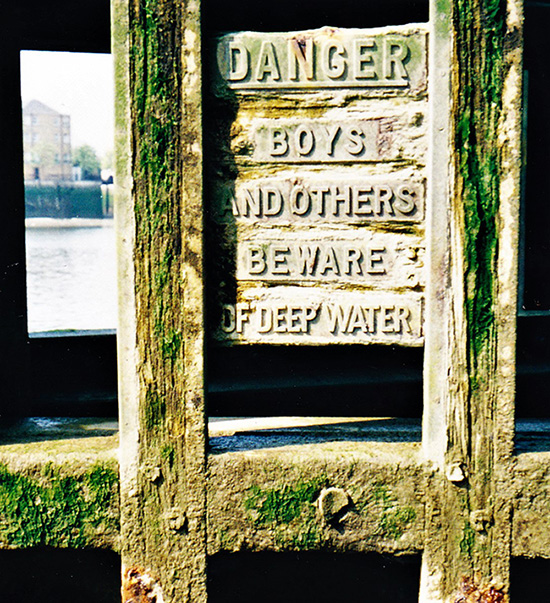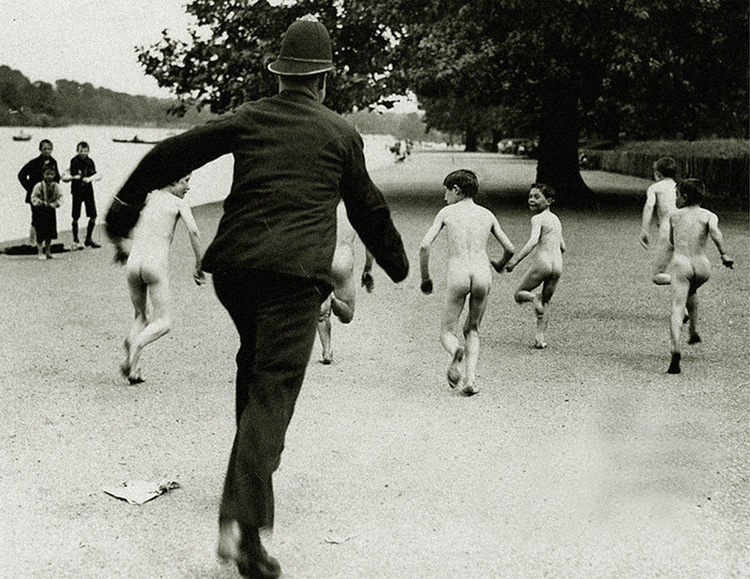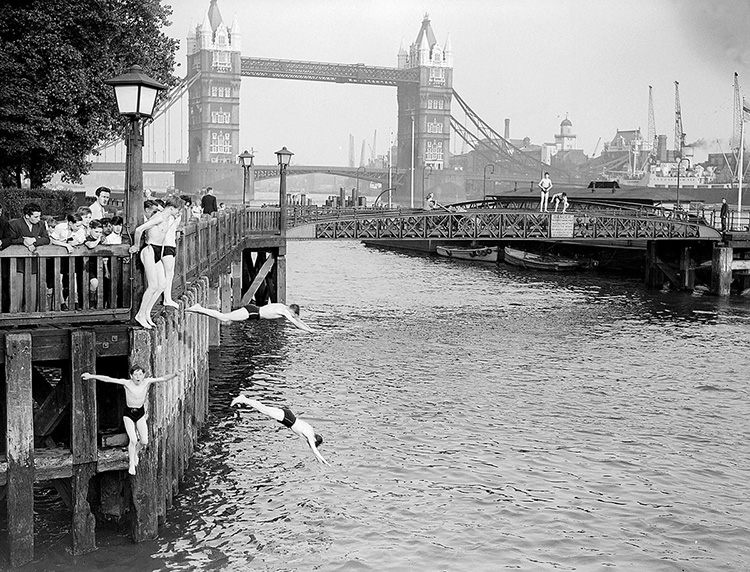Danger: Boys and others…
I took this photo in 2003. I couldn't take it now, as this part of the Limehouse foreshore is closed off. A couple of hundred years' ago, the area of shoreline was occupied by barge builders and then, in the 1920s, Blyth's Wharf jetty was built to help deliver coal to feed the nearby power station. I found hooked bits of metal and nails here, that are testament to both of these riverside working incarnations.
The wooden sign reads 'DANGER: BOYS AND OTHERS BEWARE OF DEEP WATER' (who are the mysterious 'others'?) and warns of the perils of diving here. I used to jump into Shadwell Basin (500 metres away) when I lived in Wapping, and deep was good. Problems usually arise for swimmers with cold shocks or with any unseen objects that might snag you underwater. Oh, and the fact that most Thames water is pretty disgusting to swallow!
A Royal Parks policeman chasing skinny-dippers. The photo was taken by James Jarché for the Daily Graphic in 1923 © Bridgeman
Boys have jumped and dived into London's waterways for hundreds of years. It's a free pleasure that mixes risk, naughtiness and comradeship. The sheer excitement has never been better described than in James Douglas's 'Adventures in London'published in 1909 and written several years' before. Douglas paints a wonderfully vivid picture of the bank of the Serpentine at Knightsbridge:
"In the morning, it is swarming with nude, half-nude, and quarter-nude boys. Hundreds of them, squirming and wriggling, twisting and tumbling, running and leaping, laughing and shouting, in a frenzy of youthful mirth. We are drowned in a whirlpool of boys, seething, shrieking, jumping about like landed trout, frisking like puppies, gamboling like kids, freaking like kittens. A grand ballet of boys dancing the dance of boyhood… At intervals, vigilant policemen control the merry devilry of these india-rubber imps, herding them across the fence that bounds their paradise."
Douglas also mentions that some of the 'urchins' he was observing were undernourished and their clothes threadbare and patched. The reason they were naked was that they didn't have swimming costumes nor towels. So, if they went in naked, they wouldn't rip or wet their day wear.
There were other locations along the Thames in Victorian times when boys would display their dare-devilry for money. They would jump off jetties or planks where cargo was being unloaded. Sailors or passers-by would deliberately throw in pennies just to see the boys dive in and retrieve the coins.
The picture alongside was taken in the shadow of Tower Bridge in the 1950s, probably the same time as my photo of the wooden warning sign was being made and put up.
By this time, swimming trunks were more easily affordable but these teenagers were still reliving that age-old thrill of jumping into water. A mixture of wild swimming and stylish diving.
It seems that the water was cleaner in those days bookending the Second World War. Officially opened in 1934, there was a large beach area right next to Tower Bridge. Tons of sand were brought in and parents could sit in hired deck chairs while their kids ate toffee apples bought from local vendors. There were hundreds of thousands of visitors that used this beach until 1971, when it was finally closed due to the deteriorating quality of the Thames water.
 My
last photograph is of a sign that I found below a jetty near
Wapping New Stairs. It is a double-sided metal and enamel mix,
circa 1950. Because of its location next to a jetty, it may well
have been used to summon help, if swimmers - or beach walkers - had
got into trouble along this shoreline.
My
last photograph is of a sign that I found below a jetty near
Wapping New Stairs. It is a double-sided metal and enamel mix,
circa 1950. Because of its location next to a jetty, it may well
have been used to summon help, if swimmers - or beach walkers - had
got into trouble along this shoreline.
The tidal Thames is a fast-flowing waterway and an average of one body a week is pulled out of it. The majority are suicides but the dangers are certainly there.


